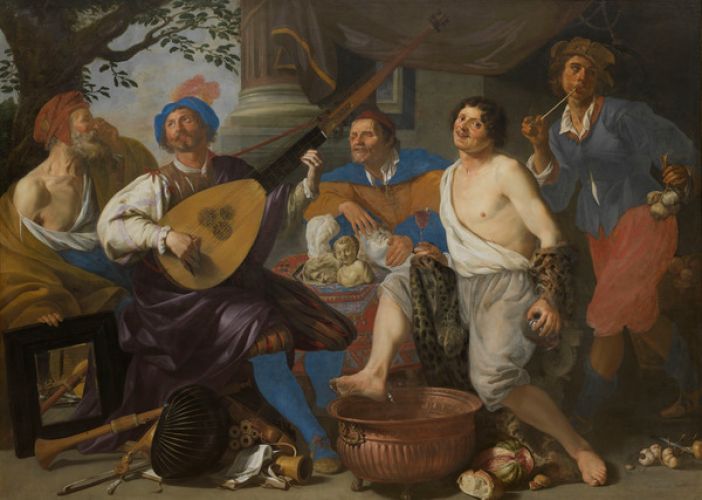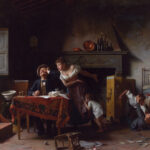
In the vibrant heart of the Flemish 17th century, each artwork encompassed a cosmos of meanings, a fabric of stories woven with symbolism and sharp observations of everyday life. Theodor Rombouts’ creations, in particular, are a vivid fresco of these multisensory narratives, masterpieces where Aristotle’s philosophy dances with the pigmentation of oil on canvas.
As human senses reach their apotheosis in these works, there is a Rombouts canvas that captures attention like few others. It unfolds a scene of diners, where every gesture and gaze evokes one of the five senses, and where the silence of still lifes is broken by the buzz of a pulsating existence.
Sight, the queen of senses, is invoked by the sparkling brilliance of a mirror capturing not just the image of an elder, but also the reflective essence of the scene. Next comes hearing, a melody soaring through the air from the touch of a lute’s strings, intoning a symphony for the soul. Then, with a delicacy bordering on the sacred, touch manifests: the fingers of a man, who do not see but feel, trace the contours of sculpted busts, telling a story of knowledge beyond sight.
Taste is made tangible not only by the promise of heady wine but also by the nuances of the story the wine itself carries, a tale of divinity and distant lands, an invitation to a sensory journey that starts from the pitcher and spreads across the canvas. Beside it, garlic, the king of smell, completes the symphony of senses with its pungent and decisive presence.
Beyond the visible, the canvas invites exploration of a deeper level of interaction, where the texture of fabrics and color choice are not mere details, but keys to accessing emotions and sensations almost palpable. Rombouts does not just represent the senses; he invites their use to decipher the hidden language of his art.
In his composition, nothing is random: every element, from the fruit on the table to the ornament on a woman’s dress, is a note in a wider score, a clue composing a timeless narrative. This is Flemish art: an invitation to pause daily haste and immerse in a world where sight, hearing, touch, taste, and smell are the protagonists of a wordless drama.
In every detail, there is a fragment of life, an experience to savor, and with this guide, the reader is led by the hand to discover the secrets hidden in the folds of a canvas. These works patiently await someone to pause and decode their enigmas, promising revelations to those willing to look, and above all, to feel beyond the visible.











